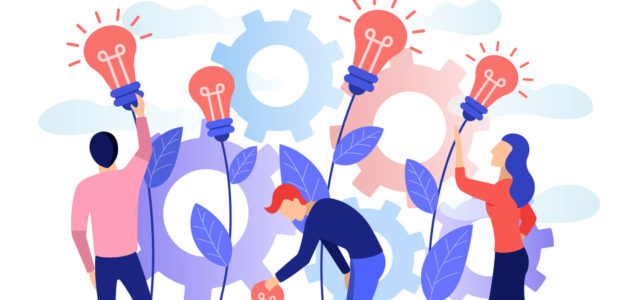“The greatest challenge for today’s leaders is how to upgrade their organisation’s operating system”. This is how we frame the conversation about organisational change and the role of digital transformation on our newly-updated website, so I thought I would explain our thinking.
Firstly, the term ‘digital transformation’ has been stretched so far that it covers anything from social media to robot process automation, and many organisations who talk about it are still in the realm of ‘put an app on it!’ rather than seriously addressing the organisational change needed to meet the opportunities and threats that digital brings.
Second, (spoiler alert!) there is no destination or target operating model that we are transforming our way towards. Change is now a constant, which means organisations need to become more agile and adaptive so that they are always evolving and co-evolving with their ecosystem, partners and predators.
Right now, most organisations are examples of the intelligent design counter-thesis to evolution – in other words, God-like, omniscient managers predict the future and issue instructions to each part of the organisational corpus that, if perfectly followed, will do what they think is needed. Even if you believe in the existence of God-like, omniscient managers, this is clearly not a system that can cope with rapid change or one which uses the collective intelligence of its people to best effect.
The reason we need agile, adaptive organisations is so that each component of the organisation is constantly seeking to independently improve its fitness function, rather than passively waiting to be told what to do from above. In evolutionary systems, this is not only more resilient and adaptive, but it is also a necessary precursor for emergence – that magical phenomenon where complex effects result from simple actions in a connected system, creating properties that are greater than the sum of its parts.
Thirdly, I think we could use a subtle shift in language around organisations. The structures, process and fabric of an organisation are really just a system that serves employees in creating value for customers, not the other way around. People use the system to get things done, and sometimes I think we fall into the trap of thinking that people should serve the organisation. The use of the term operating system, with its roots in software, is intentional. If we want organisations to adopt and use software, they need to become more like software.
There are so many lessons organisations can learn from the rapid evolution of the software field in the past two decades, from concepts like interfaces, APIs, pipelining, data handling, micro-services and the cloud to practices such as agile and DevOps. Software used to be vertically integrated and brittle, like many organisations today but evolved to become a series of pace layered services that evolve independently and build on each other to accelerate innovation.
When you think of an organisation in terms of component services, combined into platforms and systems to support the needs of employees, rather than as a set of processes run by managers in a top-down structure, it is much easier to imagine a future of more autonomy, automation, smart systems and adaptive structures.
But in our experience, the key to unlocking this change is educating today’s leaders, and encouraging the emerging leaders of tomorrow, to grasp this once-in-a-generation opportunity to re-architect the core system of management and leave behind a better organisation than the one they inherited.
Everybody knows we are hitting the limits of squeezing marginal efficiency gains from the old system, but having ascended to a powerful and comfortable position in the organisation, it takes real bravery and vision to begin a process of change that could outlast your own role. Some will grasp this challenge, but many will not.
In some cases, it is a question of building a coalition of the willing and encouraging the future firm to emerge from within the shell of the old, even if everybody does not choose to join you.
We have talked a lot over the years about how and why to humanise the enterprise, and it might seem that the idea of an organisational operating system, or automation and technology in general, sounds like it risks turning an organisation into a machine, which could be de-humanising.
But organisations today are neither human nor automated – they are more like dysfunctional machines made of management meat. People are replaceable cogs in a process-driven factory, and we allow them to bring and use too little of their humanity at work.
Digital technology, and in particular the idea of the organisation as a platform, can help us automate, standardise and orchestrate all the boring process compliance and organisational ‘wiring’ in order to create more space and time for creativity and value creation.
Just as iOS and Android platforms rigorously standardise and manage the rules, security and shared functions like authentication, notifications, etc, to support great variety at the app level, I think we will see core processes and business support functions automated and standardised at the platform level so that people and teams can combine and consume these services to operate much more freely than today.
Internal functions and teams will focus on building the best services for the organisation, and customer-facing teams will be free to combine and package them to support specific customer journeys and needs.
But the organisational operating system is clearly not just about technology. It also encompasses how we work together (culture), how teams are organised and lines of communication (structure), ways of working (practice) and how we set direction and motivate people (leadership).
In each of these domains, it is possible to define capability goals and ways of measuring progress towards them, in pursuit of an agile and adaptive organisation. And having defined capability goals in each of these areas, it makes sense to engage the whole organisation in suggesting tweaks, changes or initiatives that could help create or improve them as part of an ongoing, distributed improvement programme.
But where to begin?
If you focus on culture change without structural reform, this risks blaming employees for the failings of management and asks them to be happier / more open / etc even when the organisational structure itself mitigates against this. Investing in digitisation without addressing the divided nature of the organisation will not achieve its goals, because AI, machine learning and other exciting areas of potential value require connected data and platforms to be able to work.
If you see structure as the main challenge, but do not invest in technology, it may not be possible to support non-hierarchical models without a strong digital workplace and the ability to collaborate and connect across the organisation.
Similarly, changing your practices from a process-oriented approach to a service-oriented approach can only work if you have the technology and connected platforms that enable people to find and use these services. So too with leadership – we can encourage leaders to work in a network-centric and connected way, to support and coach, to influence and encourage, but without the tools to engage people beyond their immediate span of control, this is hard to do.
So, we believe in the need for a holistic approach to building out the organisational operating system, but of course, it does not make sense to tackle the whole organisation at once. In our work, we tend to look at three stages of development and three levels of activity, all wrapped up in a strong approach to learning and knowledge sharing:
- Optimisation – doing what you do today, but more effectively, by adopting digital workplace tools and methods
- Transformation – using digital platforms and technology to do things differently and create new strategic capabilities
- Innovation – building on your developing digital capabilities to do entirely new things, create new products or business models
These can run in parallel most of the time, though sometimes transformational activities need a higher level of digital adoption, and innovation efforts might require new digital capabilities to support or sustain them. But how they play out at different levels of the organisation can vary, for example…
- At the platform level: developing an effective digital workplace; creating a common data platform; automating and orchestrating services within a shared platform; increasing digital fluency and confidence through learning communities; cultivating a network of digital guides to spread new ways of working.
- At the team level: apply agile principles in practice; switching from process- to service-oriented ways of working; developing self-managed, data-driven teams; cultivating emergent leadership; culture and behaviour change to encourage ownership and agency.
- At the leadership level: developing digital leaders; turning budgets into investment funds; creating shared ownership of digital strategy as part of business strategy; leaders as organisational architects; capability and talent mapping.
I am spending a great deal of time running in-depth leadership learning and development sessions with senior people and emerging leaders in large corporations, urging them to take up the challenge of becoming organisational architects for the future firm.
This year, I will probably teach these techniques to over 1,000 people, and so far, the level of excitement and readiness to solve problems, remove blockers and create new capabilities in these sessions has been inspirational. I think people often forget just how hamstrung and constrained leaders can be by KPI management and the sheer challenge of maintaining performance and margins in a creaking organisational system that is ripe for renewal.
Designing transition strategies that can bring short-term improvement and cost savings, whilst building out the future operating system, can re-vitalise leadership cohorts who sometimes under-estimate their ability to affect meaningful change.
For more information on our approach, have a look at our high-level summaries of what we mean by the organisational operating system, distributed transformation and peer-to-peer learning for digital development.
Article by channel:
Everything you need to know about Digital Transformation
The best articles, news and events direct to your inbox
Read more articles tagged: Culture, Featured, Organisational Design







